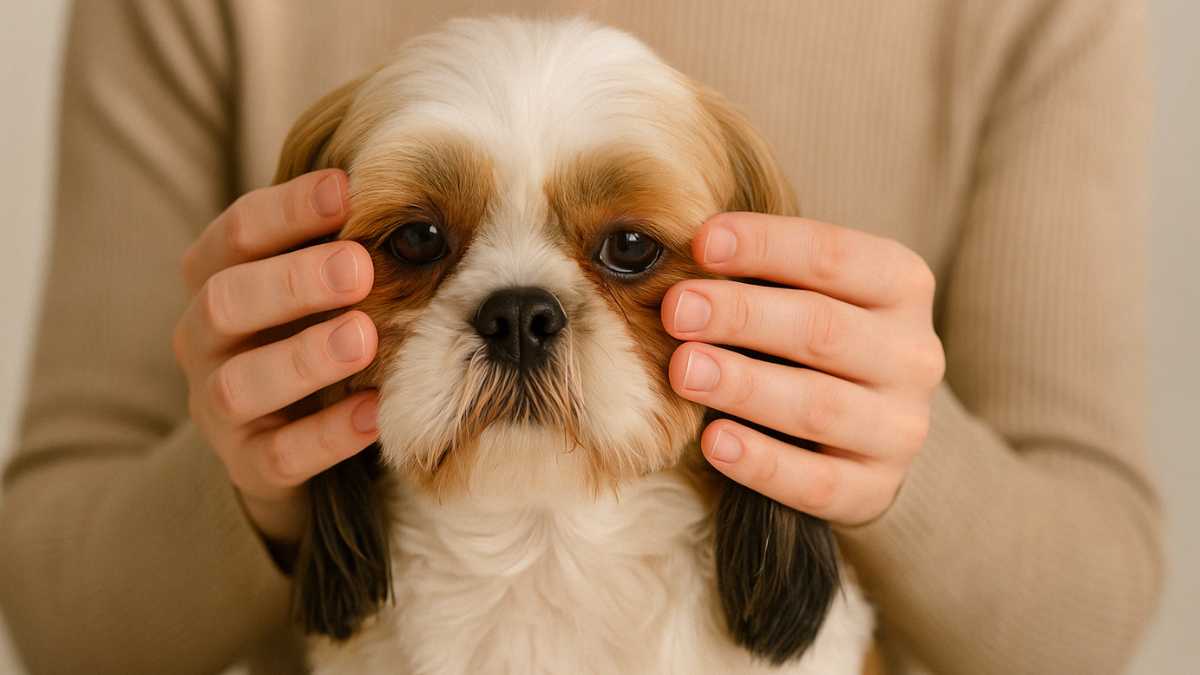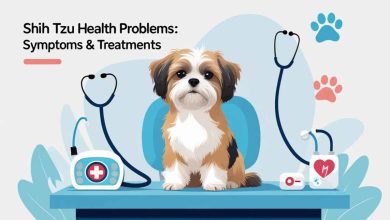Shih Tzu Eye Discharge Treatment at Home (Vet Tips Inside)

Shih Tzus are adored for their adorable faces and soulful, wide-set eyes. But those same eyes often come with a common challenge: eye discharge. If you’re a Shih Tzu parent, you’ve probably noticed tear stains, crusty corners, or watery eyes. While it can be alarming, many mild cases of eye discharge can be managed right at home, with the right care, consistency, and a little know-how.
Understanding how to treat this issue gently and effectively can keep your Shih Tzu comfortable and prevent more serious problems down the road. In this article, you’ll find everything you need to know about Shih Tzu eye discharge treatment at home, what causes it, how to prevent it, and when it’s time to call your vet.
What is Shih Tzu eye discharge treatment at home?
Put simply, it’s the process of gently cleaning and caring for your Shih Tzu’s eyes using safe, vet-approved, or natural home remedies. It includes using saline rinses, warm compresses, herbal teas like chamomile, trimming fur, and adopting preventive habits.
This form of treatment is non-invasive, often inexpensive, and can significantly reduce the risk of irritation, infection, or long-term eye problems. While it doesn’t replace medical attention when needed, it plays a powerful role in daily eye hygiene.
Why is eye discharge so common in Shih Tzus?
The Shih Tzu’s signature look—short snout, wide eyes, and flat face—is what makes them lovable but also prone to eye issues. Because their eyes are large and slightly protruding, they’re more exposed to environmental irritants like dust, pollen, and wind. Their facial hair can also irritate the eye area, especially if not regularly groomed.
Another contributor is poor tear drainage. Their tear ducts can become blocked, causing tears to spill over the eyelids and accumulate as discharge. Over time, this can also cause reddish-brown staining under the eyes due to porphyrins (pigments in tears).
Types of discharge to pay attention to
Not all discharge is the same. You might notice:
-
Clear, watery tears – often due to minor irritation or allergies.
-
Thick, mucus-like discharge – could indicate infection or blockage.
-
Crusty buildup – especially noticeable in the mornings.
-
Brown or reddish stains – known as tear stains, are common but not always harmful.
Understanding what type you’re dealing with can guide your treatment approach.
Causes behind Shih Tzu eye discharge
While some tear production is normal, persistent or unusual discharge can point to other underlying triggers. These include:
-
Allergies – environmental allergens like dust mites, grass, or even certain food ingredients.
-
Eyelid issues – inward-turning eyelids (entropion) or abnormal eyelashes.
-
Infections – bacterial or viral eye infections causing yellow or green discharge.
-
Dry eye (keratoconjunctivitis sicca) – the body doesn’t produce enough tears to lubricate the eye.
-
Blocked tear ducts – tears don’t drain properly and spill out.
-
Irritants – like cigarette smoke, household cleaners, or strong shampoos.
Benefits of treating eye discharge at home
Taking care of your Shih Tzu’s eye health at home isn’t just about saving money—it’s about being proactive. Some benefits include:
-
Prevention of serious infections
-
Avoiding unnecessary vet visits for mild issues
-
Strengthening your grooming bond with your dog
-
Less discomfort and irritation for your pup
-
Improved cleanliness and appearance
Daily attention can stop small problems from turning into painful, expensive conditions.
Effective ways to treat eye discharge at home
Let’s go over the most effective and gentle treatments you can do from the comfort of your home.
Clean with saline solution
One of the safest and most effective methods is using a homemade saline solution. Mix ¼ teaspoon of salt into 1 cup of warm, distilled water. Allow it to cool and soak a clean cotton pad or gauze.
Gently wipe from the inner corner of the eye outward, removing any gunk or crust. Use a new pad for each eye to avoid spreading bacteria. This can be done 1–2 times daily, especially in the morning and evening.
Chamomile tea compress
Chamomile has natural anti-inflammatory and soothing properties. Brew a cup of chamomile tea, let it cool, and use a soaked cotton pad to dab around your dog’s eyes. It helps reduce redness, irritation, and mild puffiness.
Do this as needed—once daily is typically enough.
Use pet-safe tear stain removers
For the reddish-brown streaks that develop under the eyes, try a tear stain remover that’s specifically designed for dogs. Make sure it’s vet-approved and free from harsh chemicals. Regular use can help fade stains and prevent new ones from forming.
Keep eye fur trimmed
Hair poking into the eyes can worsen discharge and increase the risk of infection. Using round-tip grooming scissors, carefully trim the fur around your Shih Tzu’s eyes every 2–3 weeks. If you’re unsure, a professional groomer can help.
Warm compress for crusty buildup
If the discharge has hardened into crusts, apply a warm, damp cloth to your dog’s eye for 30 seconds to soften it. Then gently wipe it away using a clean cloth or cotton ball.
Never pick or pull at dried gunk—it can irritate or damage sensitive skin.
Keep the environment clean
Many owners overlook environmental triggers. Wash your dog’s bedding regularly, vacuum often, and avoid exposing them to strong scents or cigarette smoke. Clean surroundings mean cleaner eyes.
Watch the diet
In some cases, food sensitivities can contribute to eye discharge. Consider switching to a limited-ingredient or grain-free diet and monitor your dog’s response. High-quality, natural foods often lead to better skin and coat health, including around the eyes.
Create a simple eye care routine
A daily or weekly routine helps you stay on top of your Shih Tzu’s eye health. Here’s a sample checklist:
| Task | Frequency |
|---|---|
| Saline cleaning | Twice daily |
| Chamomile compress | Once daily or as needed |
| Tear stain remover | 2–3 times/week |
| Trim eye fur | Every 2–3 weeks |
| Wash bedding | Weekly |
Consistency is key. A few minutes a day can make a huge difference.
Signs it’s time to call your vet
While home treatment is great for minor issues, some signs shouldn’t be ignored:
-
Yellow, green, or bloody discharge
-
Swelling or bulging eyes
-
Excessive pawing at the face
-
Cloudiness in the eyes
-
Squinting or sensitivity to light
-
Behavioral changes (lethargy, hiding, lack of appetite)
These symptoms may indicate serious conditions like conjunctivitis, ulcers, or glaucoma. Always err on the side of caution and consult a vet if unsure.
How to prevent future eye discharge
Prevention is just as important as treatment. Here are some expert-recommended tips:
-
Use filtered water in food and cleaning routines.
-
Keep face fur trimmed and dry—moisture invites bacteria.
-
Avoid cheap food brands with artificial ingredients.
-
Clean your dog’s eyes before and after outdoor walks.
-
Use a humidifier in dry seasons to reduce eye dryness.
A note on human medications
Never use human eye drops or ointments unless directed by a vet. Ingredients that are safe for people can be harmful—even toxic—to dogs. Stick with pet-specific solutions or natural, vet-approved remedies.
Conclusion
Caring for a Shih Tzu’s eyes is part of loving them well. Their expressive gaze is one of their most charming traits, but it comes with the responsibility of gentle, ongoing care.
With the right routine, you can manage eye discharge safely at home and spot problems before they escalate. Saline rinses, warm compresses, grooming, and environmental awareness are your best tools.
But remember—you’re not alone. If something doesn’t feel right, your vet is always the best person to guide you. A clean, comfortable Shih Tzu is a happy one—and that happiness starts with clear, cared-for eyes.
Keep your Shih Tzu’s eyes healthy—start daily care now!




